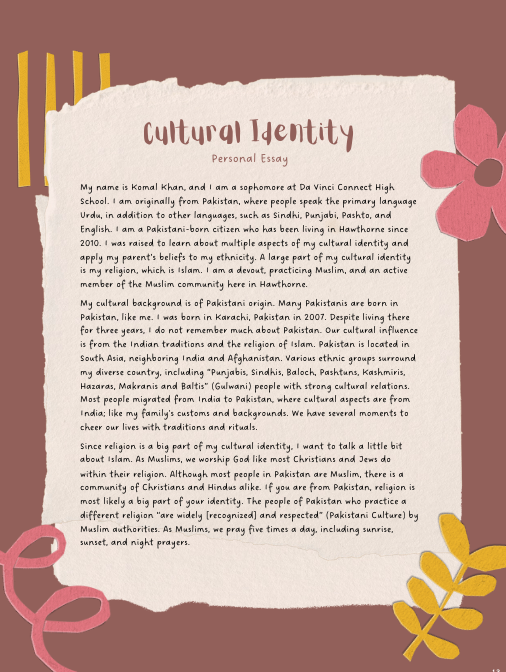
5 minute read
Cultural Identity-Personal Essay
from DV Connect Lit: Breaking Barriers- Voices of Diversity and Inclusion (Issue #001)
by dvconnectlit
By Komal Khan
My name is Komal Khan, and I am a sophomore at Da Vinci Connect High School. I am originally from Pakistan, where people speak the primary language Urdu, in addition to other languages, such as Sindhi, Punjabi, Pashto, and English I am a Pakistani-born citizen who has been living in Hawthorne since 2010 I was raised to learn about multiple aspects of my cultural identity and apply my parent’s beliefs to my ethnicity A large part of my cultural identity is my religion, which is Islam I am a devout, practicing Muslim, and an active member of the Muslim community here in Hawthorne.
Advertisement
My cultural background is of Pakistani origin. Many Pakistanis are born in Pakistan, like me I was born in Karachi, Pakistan in 2007 Despite living there for three years, I do not remember much about Pakistan Our cultural influence is from the Indian traditions and the religion of Islam Pakistan is located in South Asia, neighboring India and Afghanistan Various ethnic groups surround my diverse country, including “Punjabis, Sindhis, Baloch, Pashtuns, Kashmiris, Hazaras, Makranis and Baltis” (Gulwani) people with strong cultural relations. Most people migrated from India to Pakistan, where cultural aspects are from India; like my family's customs and backgrounds. We have several moments to cheer our lives with traditions and rituals.
Since religion is a big part of my cultural identity, I want to talk a little bit about Islam. As Muslims, we worship God like most Christians and Jews do within their religion. Although most people in Pakistan are Muslim, there is a community of Christians and Hindus alike. If you are from Pakistan, religion is most likely a big part of your identity. The people of Pakistan who practice a different religion “are widely [recognized] and respected” (Pakistani Culture) by Muslim authorities As Muslims, we pray five times a day, including sunrise, sunset, and night prayers
The other Islamic prayers are the noon and afternoon prayers. For Muslim men, it is mandatory to go to the mosque for five daily prayers, as exception allows. I go to the mosque every Friday for occasional prayers I also attend family nights and some special lectures all around the year There is a sacred month called Ramadan, in which we fast from sunrise to sundown and be considerate about the knowledge of our religion. This month is a great opportunity for us to get enormous amounts of rewards from our Creator. At the end of the month of Ramadan, we celebrate Eid ul Fitr (a special festival), with pleasure and fun This is a day for us when we are free to enjoy food, music, family, and friends Two months after Ramadan, we celebrate another festival called Eid ul Adha (a special festival to slaughter an animal), with the association of Hajj (pilgrimage to Makkah, Saudi Arabia). We slaughter an animal “to reflect the Prophet Ibrahim's willingness to sacrifice his son, Ismail, for the sake of God.” (Qurbani). Our culture and belief are to respect all members and strengthen our faith with positive attitudes.
Our clothing culture is also different from that of Western countries It is also influenced by Islamic rituals Hijab is part of the clothing in Pakistan We wear hijab in our culture because “it represents modesty, privacy, and morality”
(“Why Do Some Women Wear a Hijab?”) towards other people in society. We wear long shirts and pants to cover our bodies. Our traditional clothing shows the way of life and how we represent it in those modern times. There are different types of hats that men in various provinces wear in daily times The fashion attire “reflects on their way of living and weather conditions” (Migiro, 2019) They have been influenced by different types of rituals and are considered to be the legacy of an ancient civilization.
Our food influences Indian and Mughal traditions. Pakistani people provide street food to taste the foreign and native people with indigenous meals from other cultures For example, samosa, spring rolls, vegetable pakoras, and fruit chaat Our country makes food with spices such as “ground dried turmeric root, red chili pepper or cayenne pepper, fenugreek seeds, and ground dried coriander seeds”
(Customs and Cuisine of Pakistan) to make curry with either meat or vegetarian ingredients. Pakistan also serves rice and wheat-based products to mix with the consumed curry dish. We drink tea made out of black tea leaves and milk powder. Our republic in Asia provides yogurt drinks and fresh lime juice to carry during the summer We eat rice with meat dishes called Biryani on special occasions Both of our special festivals are associated with unique foods. Our country also makes sweet and savory dishes to take home to enjoy. We eat diverse meals that other citizens in America mostly know when they travel to different continents and countries. Mostly, we make Pakistani food at home
Overall, my cultural identity is based on my religion and where I came from. We have different traditions in our culture and experience changes that help connect us to our life. I speak English, as well as Urdu to communicate with my grandparents who are old enough to learn English. I enjoy all of my traditions, foods, and festivals. I incorporate all the aspects that my family has passed down into my own cultural identity
-Komal Khan









